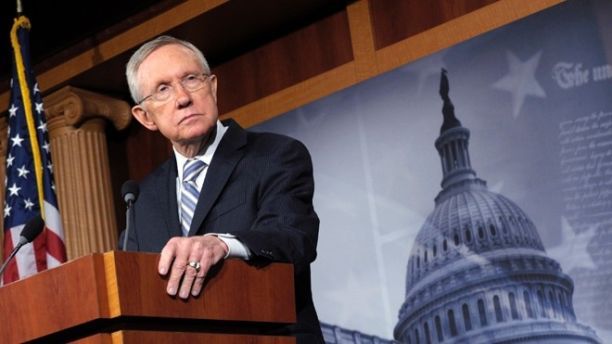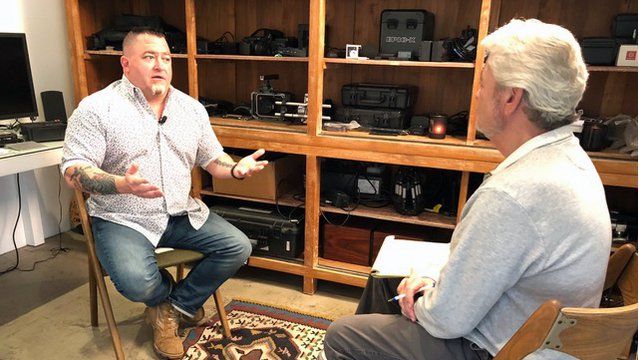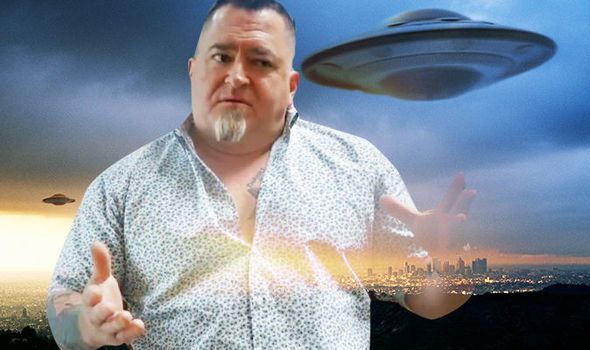Harry Reid on What the Government Knows About UFOs
by Eric Benson March 21, 2018 (nymag.com)
• In a follow-up to the New York Magazine’s March 20th article “Reasons to Believe”, this is the extended version of an interview of the former US Senate Majority Leader, Harry Reid (pictured above), about the US government’s research into the topic of UFOs and extraterrestrial life.
• When Reid began to practice law in Las Vegas in the 1960’s, one of his first cases involved the local owner of Bigelow Carpet Company who died in a plane crash at LA Int’l Airport. His son and heir, Robert Bigelow, was told by his grandparents about an incident when they themselves saw a UFO near Las Vegas. As Bigelow increased his own wealth in hotels and real estate, he would financially sponsor UFO seminars and conferences, bringing in scientists and academics.
• Reid’s friend, popular Nevada TV journalist George Knapp, introduced Reid to Robert Bigelow. Bigelow began sending Reid material on UFOs and extraterrestrials which Reid found interesting. Bigelow’s approach to the study of UFOs was more scientific than fanciful, and as he began accumulating information, he built a warehouse in which to store all of this information. In time, Reid would also speak with people such as John Glenn, Bill Clinton, and John Podesta on the subject.
• When Reid had become the leader of the Senate, he reached out to two close friends – Senator Ted Stevens of Alaska and Senator Daniel Inouye of Hawaii – about this UFO phenomenon. Stevens revealed that as a pilot during WWII, he had flown next to a UFO. As Stevens and Inouye controlled the Defense Appropriations Subcommittee, they decided to create the Pentagon UFO research program, and awarded the $11M contract to Robert Bigelow ‘because he had spent his own money first’. But it remained a secret program, says Reid, “because I wanted to get something done. I didn’t want a debate that no one knew what the hell they were talking about on the Senate floor.” Reid was never even briefed on the program afterward.
• Reid says that this Pentagon research program has generated hundreds upon hundreds of pages of information, 80% of which has been available to the public. “You know something?” says Reid, “the press has never even looked at it. Not once. That’s where we are. I wanted it public, it was made public, and you guys have not even looked at it.” “So, in short, it’s my belief you guys kind of want to be spoon-fed. You don’t want to do any work on your own.”
• “I’m glad somebody is interested, because it’s a subject that is being terribly neglected,” says Reid. “I’m happy to talk to you.”
Yesterday, we outlined thirteen reasons to take recent reports of UFOs and extraterrestrial life seriously, including a chat with former Senate majority leader Harry Reid about the government’s research into the topic. Here, an extended version of that conversation.
Hi, this is Eric Benson from New York Magazine.
Hi, Eric. Why do you want to talk to me?
Well, because of the New York Times article and the program that you helped bring about.
Well, I’m happy to talk to you. Just let me preface this by saying this, if we’re here to talk about little green men or stuff that you want to look at that was found in New Mexico or something, I’m not interested. If you’re here to talk about science, I’m happy to do that. I’m really glad to do that. I’m glad somebody is interested, because it’s a subject that is being terribly neglected, so I’m happy to talk to you.
Great. Well, I don’t want to talk to you about little green men.
Okay.
One thing I am curious about, though, is just where your interest in this subject comes from.
That’s pretty easy. When I first got out of law school many, many years ago, in the mid-’60s, I worked with three other lawyers. A big case we had was a case involving a bunch of rich Las Vegas businessmen. They went into L.A. International Airport, tried to take off, and the plane crashed and killed them all. It was a very interesting case. It went to Supreme Court, a mistrial declared, hung jury, went on for years.
One of the people who was killed in that plane crash was a guy by the name of Bigelow. He was not as wealthy, but he was a wealthy man in Las Vegas who ran a carpet company, Bigelow Carpet. His son was 18 years old when that crash occurred. He’s a central figure in all this. I didn’t know him, but when he was a young man, he heard a story from his grandparents about driving down from Mt. Charleston — that’s a 12,000-foot mountain just ten miles out of Las Vegas — where they saw something in the air. This so-called flying saucer, for lack of a better description. It piqued his curiosity.
He became a very wealthy man. I mean extremely wealthy. During the time that he had some money, he said, “I would like to know more about this.” He would have, several times a year, at his big office here in Las Vegas — knew how to make money buying and selling real estate. He would pay for these seminars, these conferences, and he would bring in scientists, academics, and a few nut cases. That’s a bad way of talking about some people, but, you know — people who were really, in my opinion, kind of on the fringes.
Probably the No. 1 TV journalist in Nevada was a guy by the name of George Knapp. He and I were friends. He had known me for years. He said to me one day, “Hey, I know this guy Bigelow, he’s interested in a subject, I don’t know if you have any interest in it all, but you should get to know him. He’s got a lot of money. He’s kind of an interesting guy. I’ll introduce you. You’ll go to one of those little deals and spend a few hours with him.”
I did that. It was really fascinating quite frankly because there were people trying to figure out what all this aerial phenomenon was. Bigelow knew I was interested.
I’ve always been a voracious reader. I blinded myself in one eye — I used to read really, really fast, and I can still read fairly fast with only one eye; not nearly as fast as I used to. Just a little side note: I took the Evelyn Wood Reading Dynamics course here in Las Vegas, and I was told I was the fastest reader they ever had in Nevada. I can read so fast.
How fast are you? Is there a number that represents —
I don’t know. I don’t know. But anyway, to make a long story short, he started sending me tons of stuff. I mean tons of stuff. I read it. A lot of it was nothing that interested me. It was, they reexamined and examined and reexamined the crash in New Mexico that happened down there that everybody knows about that knows anything about this subject. It was repetitive, and I didn’t care. But there was some stuff that interested me. Mainly what interested me is so many people had seen these strange things in the air. That was interesting to me.
I’m in the Senate now and one day was joined by John Glenn, who I thought was just such a wonderful human being. I said to John, “Hey John, I’ve been reading all this stuff, do you have any interest in it?” He said, “I’ve always had an interest in it.” You get the picture so far, right?
Yeah.
I’m in Washington in the Senate and Bob Bigelow called me — I kept in touch with him over the years. He called me and he said, “I got the strangest letter here. Could I have a courier bring it to you?” I said, “Sure.” He didn’t want to send it to me over the lines for obvious reasons.
I read the letter. The letter was from a federal national-security agency. Okay? The letter said, “I am a senior, longtime member of this security agency, and I have a Ph.D.” — I can’t remember in what, in physics for sure, maybe math also. “And,” the letter said, “I’m interested. I’m interested in talking to you, Mr. Bigelow. I have an interest in what you’ve been working on. I want to go to your ranch in Utah.”
Bigelow had bought a great big ranch, a 70-, 100-acre ranch in Utah that was in a basin for more than a century.
Was that the Skinwalker Ranch?
Yeah, that’s it. I called Bigelow back and said, “Hey, I’ll meet with the guy.” I called the guy. He said, “I don’t want to meet at my office, I don’t want to meet at your office. Where can we meet?” I said, “Come to my home.” The two of us met and I was terribly impressed with him. Very low-key scientist. He told me of his interest. I called Bigelow and I said, “This guy, I’ve checked him out and he seems like a pretty nice guy and his credentials are as he says.”
He went, met Bigelow, and after I don’t know how much time went by, he came to me and said, “Something should be done about this.
Somebody should study it.” I was convinced he was right. I said, “Well, if you were me, what would you say to people in power in the United States Senate who have huge control over the spending of defense money?” And here’s what he said: “What I will do is prepare something for you that anyone can look at it that wants to, it’s strictly science.” He put it in scientific language — what the study should consist of.
I, at the time, was the leader of the Senate, and I called two of my friends who for many, many years were like brothers. One a Democrat, one a Republican. They controlled for quite a number of years the Defense Appropriations Subcommittee. It was Stevens and Inouye.
As I said in the New York Times article, it was the easiest meeting I ever had. I walked in and I knew so much and Ted Stevens interrupted me and said, “I’ve heard enough.” He said, “Since I was a pilot in World War II, I’ve been tremendously curious, concerned about stuff that we don’t know anything about.” He said, “I was in my airplane alone and off to my left was an object. I could see it. It was so close to me. I would veer up, down, sideways. Wherever I went, it was there. I was starting to get low on fuel, went and landed, and went to the air-traffic controller. I said, ‘Was there anybody up in the air with me?’ The guy said, ‘I don’t know what you’re talking about.’”
That’s why it was an easy sell for him. He, Ted Stevens, when he was in the military, didn’t go to his superior and say, “I saw the damnedest thing in the air.” Why? Because the work we did, pilots would almost refuse to report this stuff. Why? Because it would hurt them in their promotions and make them look like goofballs.
What we decided to do — it would be black money, we wouldn’t have a big debate on the Senate floor over it. They would put in their defense appropriation bill, 11 million bucks. The purpose of it was to study aerial phenomena. The money was given, a directive was given to the Pentagon, to put this out to bid, which they did.
People may be inquisitive: “How did Bigelow win that bid? Why?” Because he had spent his own money first. For two years, the federal government helped him. Thousands of pages were gathered, just like I told you, of things that had happened. There was no central location where all this stuff was gathered — that’s what he did. He built his building for it. For two years, when we got financial help — but there was a change in leadership and it didn’t work. So the federal government dropped out of the project.
As you’ve heard from a few people since this story came out, Luis Elizondo, for example, he quit, because they wouldn’t do anything seriously. He was terribly interested in this. They’re all mad because the federal government has done nothing. The guy that came to me, his job was in jeopardy because he tried to do something he felt was appropriate. He said to me first time we met, “I don’t know why we’re not doing anything.” He said, “I’ll bet the Chinese are.” He said, “I’ll bet the Russians are. I’ll bet the Japanese are. Why aren’t we doing anything?”
That’s the story. You’ve got in a nutshell, that’s how I got involved in this.
FAIR USE NOTICE: This page contains copyrighted material the use of which has not been specifically authorized by the copyright owner. ExoNews.org distributes this material for the purpose of news reporting, educational research, comment and criticism, constituting Fair Use under 17 U.S.C § 107. Please contact the Editor at ExoNews with any copyright issue.


